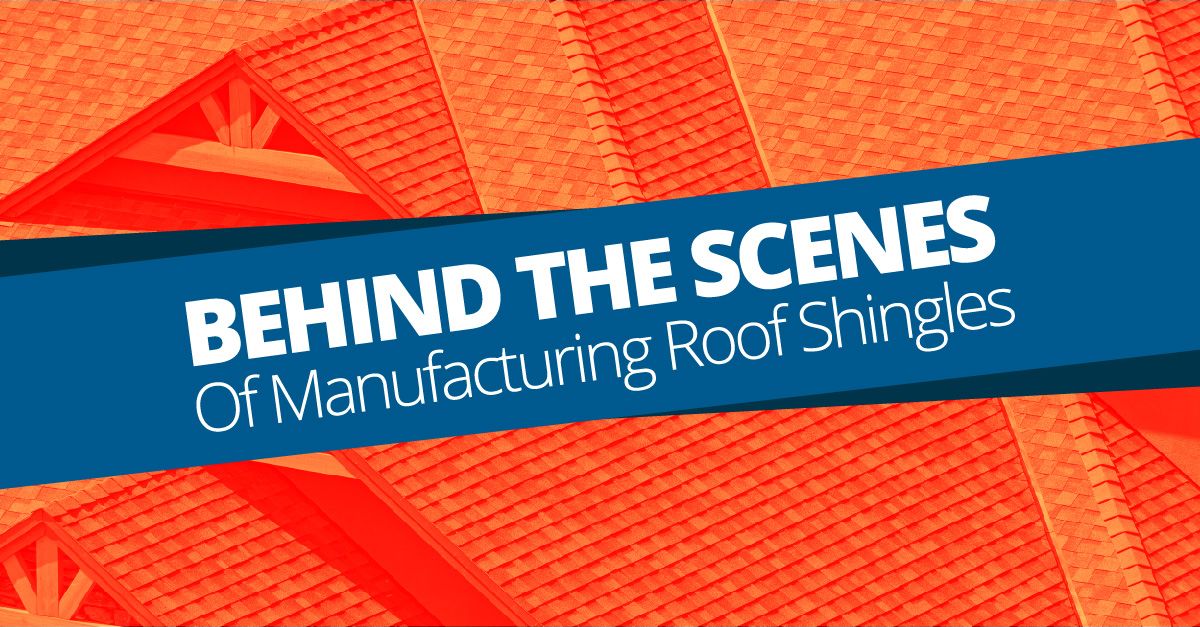
You look up with pride at your new shingle roof and wonder, “How are roof shingles made?” You know your new roof will provide a couple of decades of reliable, weather resistant service, but how do they do that? Here is a peek behind the scenes of roof shingle manufacturing, a combination of earth’s raw resources and human ingenuity.
Basic Ingredients
Humans have been putting roofs over their heads for millennia. Now, as then, we rely on resources drawn from the earth to keep the wind and water off our heads. Shingle roofs are built piece by piece from fiberglass-asphalt shingles, manufactured from some simple ingredients.
- Fiberglass — Combining stable resins and glass fibers, the thin mat of fiberglass gives each shingle its remarkable strength and durability
- Asphalt — Oxidized, processed asphalt is extracted from refined oil to provide the exact viscosity needed for long-lasting shingles
- Stone granules — Actual crushed rock, in the color you choose, is fired in ovens and sieved, then applied to each shingle
- Sealant — Heat-activated asphalt sealant is applied to the underside of each shingle to allow it to stick and grip surely to the shingle it overlays after installation
- Release film — A thin plastic strip which prevents asphalt sealant from sticking while the shingles are stored in bundles
Highly Precise Manufacturing
Gathering the right ingredients, as any chef knows, is not the whole cake. Proper mixing, careful blending, and constant vigilance are all needed during preparation to ensure a uniformly superior product.
Granules alone require many steps. Some shingles use highly reflective granules which allow shingles to qualify for Cool Roofing, saving homeowners and businesses money on energy bills. Some granules are treated to be algae resistant, preventing those odd discolorations and stains so common to older shingle homes.
Asphalt, too, must be precisely oxidized (by blowing air through the hot liquid asphalt) to get a consistency which is neither too thin nor too thick. The wrong viscosity will cause a shingle to be either too brittle or too soft, leading to early failure.
Imagine an intricate cake made not with food but with fiberglass, surfaced on both sides with asphalt coating. Another layer is added on the top, with the granules embedded into the still-warm asphalt. A strip of asphalt adhesive is applied to the back and immediately covered with the release film.
We are still not done making our sturdy, economical fiberglass-asphalt shingle. Since asphalt is slightly sticky, the back of each shingle receives a final coating of mineral powder to prevent the shingles from becoming a single, solidified, laminated mass in the package. This back surfacing allows easy handling but still allows the shingles to soften and meld together over time, on your roof.
Architectural Shingles
Some shingles, such as deeply dimensional architectural shingles with their dramatic cut lines and multiple shadowing, require laminate layers. These beautiful, eye-catching, high-quality shingles are so thick, they instantly draw the eye to steep residential roofs, boosting curb appeal while still performing the basic job of a shingle: shedding water and sheltering your home.
Multi-layer laminated shingles may have as many as six-dimensional layers, mimicking hand-cut wood shakes or thick slate. To achieve these layers, laminate holds each asphalt and fiberglass sheet together, increasing the shingle’s strength and ability to withstand wind uplift.
Half the Recipe
Of course, highly precise manufacturing and quality ingredients are only half of any recipe. The other half is the person controlling the final product. In the case of shingles, you need a trustworthy, local roofer capable of installing the shingle according to manufacturer’s directions.
This sounds simple but often is not as easy as it appears. Roofs are integrated systems, from sheathing to underlayment to starter courses to ridge vents. Every component must be expertly installed for the whole system to work.
Indeed, manufacturers’ warranties specify that improperly installed material voids the warranty. The value of a shingle warranty is that your roof will be repaired or replaced at no cost if the problem is the shingle, not the installation.
Protect your warranty. Protect your home. Choose a local, experienced roofing contractor capable of putting down a shingle roof the right way.
Finding a Roofer
Few people face reroofing, or even roof repairs, more than once or twice in the life of their home. You probably have no network of contractors, builders, or real estate agents. You must rely on unbiased, independent organizations to help you find a trustworthy roofer.
One good source: the manufacturers themselves. Look to companies like these for their recommendations of roofers:
- APOC Certified applicators
- CertainTeed
- GAF
- Owens Corning
If you’re looking for a certified roofer in Los Angeles, then contact Roof Repair Specialist to find out how we can make the repairs you need, help you select the right shingles for your new roof, and preserve your home’s value.



